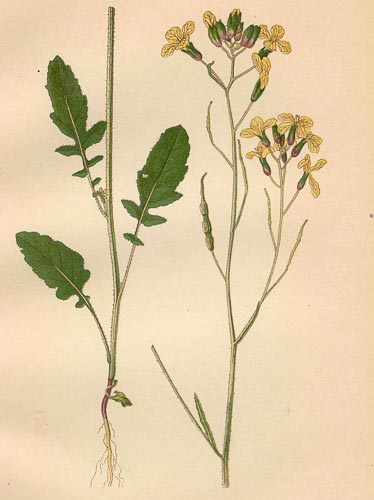Weeds
Raphanus raphanistrum L. - Wild radish.
Taxonomy.
Family Brassicaceae Burnett (Cruciferae Juss.), Genus Raphanus L.Biology type.
Spring annual weed.Morphology and biology.
Plant is 20-60 cm in height, covered with rigid hairs. Stem is upright. Leaves are lyre-pinnatipartite, with 4-6 uneven-dentate ovate-oblong lobes and bigger top lobe. Inflorescence is raceme. Flowers are actinomorphic, consisting of four components, petals are situated crosswise, usually yellow, more rarely white or with lilac hue. Fruit is silicle, articulated, its lower part is bead-like, grooved length wise, its upper part is stretched out to a long conical tip. Silicle is ligneous, glabrous, stramineous, divided into segments across false partition walls when ripened. Seeds are oval-globular, russet, their surface is reticular, lustreless. Seeds covered with segment walls maintain their germinability up to 18% passing through the digestive system of animals. Plant flowers in May-September, bears fruits in July-October. Maximum productivity is up to 2500 seeds. Minimum temperature of seed germination is 2-4°C. Seeds germinate best from depths of no more than 3-4 cm, and seed remains viable in soil for 10 or more years.Geographical range.
It occurs across European part of the Former Soviet Union, more rarely in Caucasus, Siberia and Far East. General distribution: Western Europe except northern Scandinavia, West Asia, Syria, and as an adventive plant in North America.Ecology.
Anthropochore, autochore. It prefers loose soils. During seedling and fruiting stages this plant stands frosts down to -11°C, but does not over-winter. It is prolific in wet years with cold springs. Fruits of this weed ripen before harvest of early cereal crops, many fruits burst, and seed infests soil. Seed also contaminates crop yield during harvest. R. raphanistrum is mainly disseminated among cereal seeds.Economic value.
This weed mainly infests spring crops in the Non-Chernozem region of the Former Soviet Union. In southern regions, it is found but is not significant as a weed plant. It also occurs in fallows, and along roads as a ruderal plant. R. raphanistrum is used as a bee plant, industrial oil in extracted from seeds. Control measures: early plowing and shallow plowing in autumn, use of decomposed manure. Purification of crop seeds in triers.Reference citations:
Agaev M.G., ed. 1988. Main agricultural weeds in crops of the Leningrad Region. In: Catalogue of VIR world collection. Leningrad: VIR. N. 468: 44-46. (In Russian)Keller B.A., ed. 1934. Weed plants of the USSR. Leningrad: AN SSSR. V. 3: 67-69. (In Russian)
Komarov, V.L & N.A. Bush, eds. 1939. Flora of the USSR. Moscow-Leningrad: AN SSSR. 494-495 pp. (In Russian)
Korsmo E. 1933. Weed plants of modern farming. Moscow-Leningrad: Publishing House of Kolchoz & Sovchoz Literature. 115-116 pp. (In Russian)
Nikitin V.V. 1983. Weed plants of the USSR flora. Leningrad: Nauka. 214 p. (In Russian)
Ulyanova T.N. 1998. Weed plants in flora of Russia and other CIS countries. St. Petersburg: VIR. 232-234 pp. (In Russian)
Zotova A.P. 1971. Weed plants and their control. Leningrad: Lenizdat. 58, 60 p. (In Russian)


